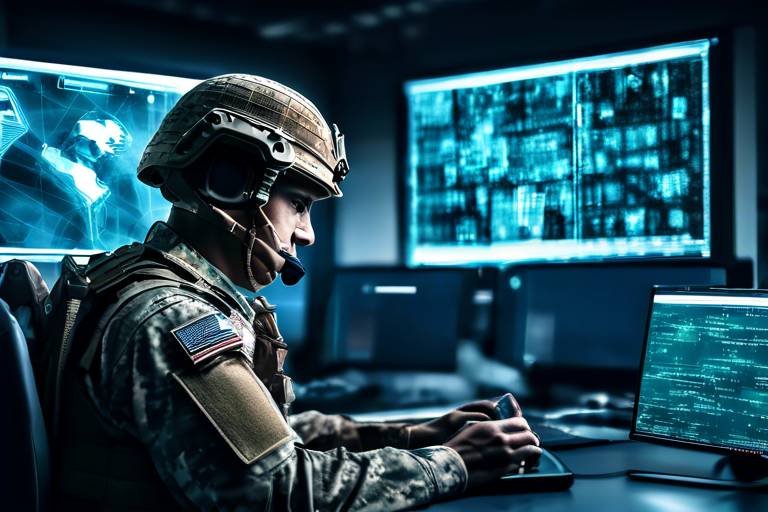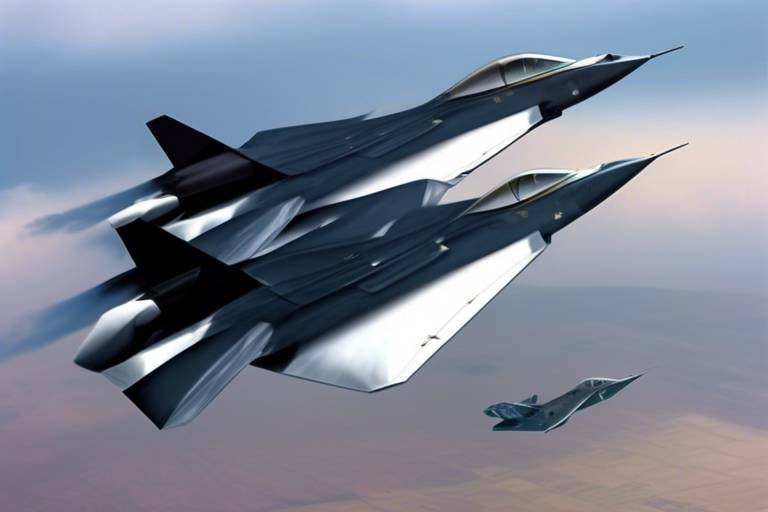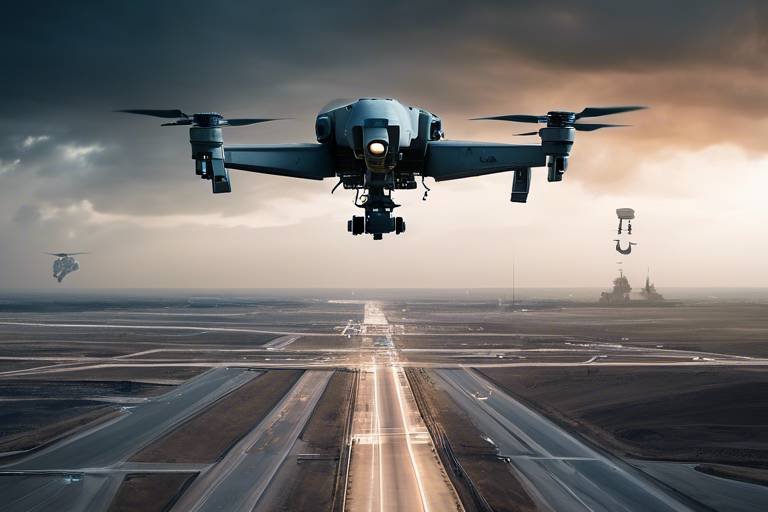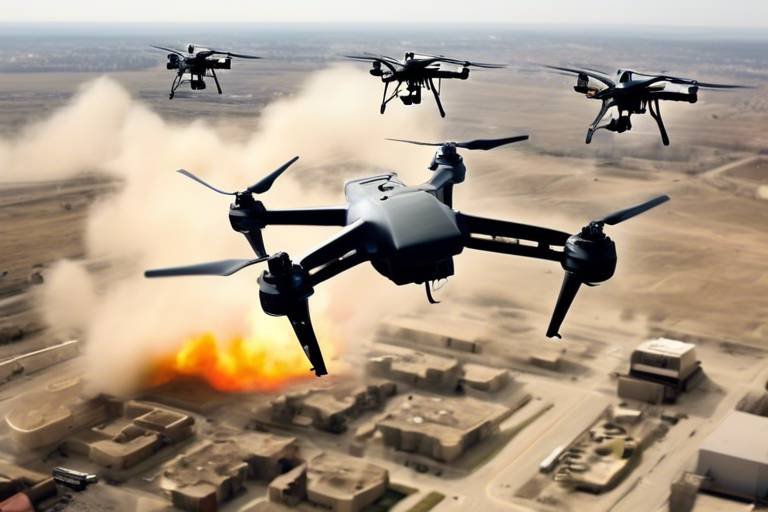AI-Based Cybersecurity Solutions for Military Operations
In a world where cyber threats are constantly evolving, the military is facing unprecedented challenges in safeguarding sensitive information and operational integrity. The integration of artificial intelligence (AI) into cybersecurity strategies is transforming how military organizations defend against these threats. AI technologies are not just buzzwords; they are becoming essential tools that enhance threat detection, improve response times, and bolster overall operational security. Imagine having a digital soldier that can analyze vast amounts of data in real-time, identifying potential threats faster than any human could. This is not science fiction; it is the reality of modern military operations.
As we delve deeper into the world of AI-based cybersecurity, it's essential to understand the core principles that underpin these technologies. AI systems are designed to learn from data, adapt to new information, and make decisions that can significantly impact military effectiveness. By leveraging machine learning algorithms and deep learning techniques, military cybersecurity can evolve from reactive to proactive, anticipating threats before they materialize. This shift is crucial in a landscape where every second counts, and the ability to neutralize threats swiftly can mean the difference between mission success and catastrophic failure.
The implications of AI in military cybersecurity extend beyond mere threat detection. With automated response systems, military forces can mitigate potential damage during cyber incidents, ensuring that critical operations remain unaffected. The ability to respond to threats in real-time not only safeguards vital data but also maintains the trust and confidence of personnel and stakeholders alike. However, as we embrace these advanced technologies, we must also navigate the challenges and limitations they present, including data privacy concerns and ethical considerations.
As we explore the future of AI in military cybersecurity, it is clear that collaboration between military organizations and technology innovators will be key to driving advancements. Emerging technologies, such as quantum computing, hold the potential to revolutionize AI capabilities, paving the way for even more robust defense mechanisms. The military must stay ahead of the curve, ensuring that its operations remain secure against an ever-evolving threat landscape. The marriage of AI and military cybersecurity is not just a trend; it is a necessary evolution in the fight for national security.
- What is AI-based cybersecurity? AI-based cybersecurity refers to the use of artificial intelligence technologies to enhance the protection of computer systems, networks, and data from cyber threats.
- How does AI improve threat detection? AI improves threat detection by analyzing large datasets, recognizing patterns, and identifying anomalies that may indicate a cyber threat.
- What are the benefits of automated response systems? Automated response systems can neutralize threats faster than human operators, reducing the potential damage during cyber incidents.
- What challenges does AI face in military cybersecurity? Challenges include data privacy concerns, ethical considerations, and the need for secure data handling practices.
- What is the future of AI in military operations? The future includes advancements in AI technologies and collaboration with tech innovators to enhance cybersecurity measures.

Understanding AI in Cybersecurity
Artificial Intelligence (AI) is not just a buzzword; it's a revolutionary force that's transforming the landscape of cybersecurity, especially in military contexts. Imagine having a digital guardian that can analyze mountains of data in the blink of an eye, identifying threats before they even emerge. That's the power of AI! By employing advanced algorithms and machine learning techniques, AI systems can sift through vast data sets, pinpointing anomalies and potential threats in real-time.
At its core, AI in cybersecurity leverages complex mathematical models to replicate human-like decision-making processes. This means AI can learn from past incidents, adapt to new threats, and even predict future attacks. For military operations, where the stakes are incredibly high, this capability is invaluable. With the ability to analyze patterns and behaviors, AI can help military personnel focus on strategic decision-making rather than getting bogged down by mundane data analysis.
Consider this: traditional cybersecurity measures often rely on predefined rules and signatures to identify threats. This approach can leave gaps that sophisticated cyber adversaries exploit. In contrast, AI systems continuously learn and evolve, making them far more adept at detecting new and unknown threats. They can analyze a variety of data sources, including network traffic, user behavior, and even external threat intelligence feeds, to build a comprehensive picture of the cybersecurity landscape.
One of the most fascinating aspects of AI in cybersecurity is its ability to operate at lightning speed. While human operators may take minutes or even hours to analyze data and respond to threats, AI can accomplish this in mere seconds. This rapid response capability is crucial for military operations, where every second counts in preventing potential breaches or attacks.
Furthermore, AI's analytical prowess extends to predicting potential vulnerabilities and offering proactive solutions. By utilizing predictive analytics, military cyber teams can anticipate possible attack vectors and reinforce defenses before an incident occurs. This proactive approach significantly enhances operational security, ensuring that military networks remain resilient against evolving cyber threats.
However, it's essential to understand that while AI offers tremendous benefits, it is not a panacea. The implementation of AI in cybersecurity must be approached with caution, considering factors such as data privacy, ethical implications, and the need for human oversight. As we delve deeper into the intricacies of AI-driven cybersecurity solutions, it's crucial to balance innovation with responsibility.
- What is AI in cybersecurity? AI in cybersecurity refers to the use of artificial intelligence technologies to enhance the detection, analysis, and response to cyber threats.
- How does AI improve threat detection? AI improves threat detection by analyzing vast amounts of data in real-time, identifying patterns and anomalies that may indicate a cyber threat.
- What are the challenges of using AI in military cybersecurity? Challenges include data privacy concerns, ethical considerations, and the need for robust human oversight to ensure responsible use of AI technologies.
- Can AI predict cyberattacks? Yes, AI can utilize predictive analytics to anticipate potential vulnerabilities and threats, enabling proactive defense strategies.

Threat Detection and Analysis
In the realm of military operations, the stakes are incredibly high, and the need for robust threat detection capabilities cannot be overstated. With the rise of sophisticated cyber threats, traditional security measures often fall short. This is where artificial intelligence (AI) steps in, revolutionizing how military organizations approach cybersecurity. By leveraging advanced machine learning algorithms, AI can analyze vast amounts of data in real-time, identifying potential threats before they escalate into serious incidents. Imagine having a vigilant guard that never sleeps, constantly monitoring the digital landscape for any signs of intrusion or malicious activity.
AI's ability to enhance threat detection is primarily rooted in its capacity to recognize patterns and anomalies in data. Machine learning algorithms can be trained on historical data, enabling them to understand what normal behavior looks like within a network. When an anomaly is detected—say, a user accessing sensitive information at an unusual hour—the system can trigger alerts, allowing military personnel to respond swiftly. This proactive approach significantly reduces the window of opportunity for cyber adversaries, ensuring that military operations remain secure.
At the heart of AI's threat detection capabilities are machine learning algorithms. These algorithms can be categorized into various types, each with its unique strengths. Some of the most commonly used algorithms in cybersecurity include:
- Decision Trees: These algorithms make decisions based on a series of questions, creating a tree-like model of decisions that leads to a conclusion about whether a threat exists.
- Random Forests: An extension of decision trees, random forests use multiple trees to improve accuracy and reduce the likelihood of false positives.
- Support Vector Machines (SVM): SVMs classify data points by finding the optimal hyperplane that separates different classes of data, making them effective in identifying anomalies.
- Neural Networks: These are particularly powerful for recognizing complex patterns in large datasets, making them well-suited for analyzing intricate cyber threats.
Each of these algorithms plays a critical role in enhancing the accuracy of threat detection within military networks. By employing a combination of these techniques, military organizations can achieve a more comprehensive understanding of their cybersecurity landscape, effectively reducing the number of false positives that can overwhelm security teams.
When it comes to training AI systems for military applications, understanding the difference between supervised and unsupervised learning is essential. In supervised learning, algorithms are trained on labeled datasets, meaning they learn from examples that have known outcomes. This approach is particularly effective for tasks where historical data is available, allowing the system to learn what constitutes a threat based on past incidents.
On the other hand, unsupervised learning involves training algorithms on data without predefined labels. This method is beneficial for discovering hidden patterns or anomalies that may not have been previously identified. For military operations, this means that AI can uncover new types of threats that have not been encountered before, providing an additional layer of security.
Deep learning, a subset of machine learning, uses neural networks with multiple layers to analyze complex data structures. This technique is particularly effective in cybersecurity because it can process vast amounts of unstructured data, such as network logs and user behavior patterns. By utilizing deep learning, military organizations can enhance their decision-making processes, allowing for quicker and more accurate responses to emerging cyber threats.
In summary, the integration of AI in threat detection and analysis is transforming military cybersecurity. With its ability to analyze data rapidly and accurately, AI not only improves the chances of identifying threats before they cause harm but also streamlines the overall security process, enabling military personnel to focus on their core missions. As cyber threats continue to evolve, the reliance on AI-driven solutions will undoubtedly become even more critical.
AI plays a crucial role in enhancing threat detection, response times, and overall operational security by analyzing vast amounts of data to identify potential threats in real-time.
Machine learning algorithms analyze patterns and anomalies in data, allowing military operations to respond swiftly to emerging cyber threats while reducing false positives.
Supervised learning involves training algorithms on labeled datasets with known outcomes, while unsupervised learning analyzes data without predefined labels to uncover hidden patterns.
Deep learning techniques use neural networks with multiple layers to analyze complex data structures, making them effective for processing unstructured data in cybersecurity.

Machine Learning Algorithms
When it comes to enhancing cybersecurity in military operations, are like the secret sauce that makes everything work seamlessly. These algorithms are designed to analyze vast amounts of data, learning from patterns and anomalies that human operators might overlook. Imagine having a super-sleuth at your disposal, one that can sift through terabytes of information in the blink of an eye, pinpointing threats before they even materialize. This capability is crucial in military contexts where every second counts and the stakes are incredibly high.
One of the standout features of machine learning algorithms is their ability to improve accuracy in threat detection. Traditional methods often rely on predefined rules that can quickly become outdated or ineffective against sophisticated cyber attacks. In contrast, machine learning continuously evolves, adapting to new threats as they emerge. For instance, a military network under attack can leverage these algorithms to identify unusual login patterns or data access requests that deviate from the norm, triggering an immediate alert to cybersecurity personnel.
Moreover, these algorithms significantly reduce the incidence of false positives, which can be a major headache in cybersecurity operations. Imagine a scenario where a military base's network is flooded with alerts due to benign activities mistakenly flagged as threats. This not only wastes valuable time but also diverts attention from real threats. With machine learning, the system learns from past incidents, refining its ability to distinguish between genuine threats and harmless anomalies. This leads to a more streamlined and efficient response process.
To illustrate the effectiveness of machine learning in military cybersecurity, consider the following table that outlines some common algorithms used in this field:
| Algorithm Type | Description | Application in Cybersecurity |
|---|---|---|
| Decision Trees | A flowchart-like structure that makes decisions based on data attributes. | Used for classifying network traffic and identifying malicious behaviors. |
| Neural Networks | Inspired by the human brain, these networks recognize patterns through interconnected nodes. | Effective in detecting sophisticated cyber threats by analyzing complex data. |
| Support Vector Machines (SVM) | A supervised learning model that finds the best boundary between classes of data. | Helps in separating normal traffic from potential threats in real-time. |
In summary, the implementation of machine learning algorithms in military cybersecurity is not just a trend; it's a critical evolution that enhances operational security. By leveraging these advanced technologies, military organizations can stay one step ahead of cyber adversaries, ensuring that they are prepared for any threat that might arise. As we move forward, the integration of these algorithms will only become more sophisticated, paving the way for a future where military networks are fortified against even the most cunning cyber attacks.
- What are machine learning algorithms? - Machine learning algorithms are computational methods that enable systems to learn from data and improve their performance over time without being explicitly programmed.
- How do machine learning algorithms improve cybersecurity? - They analyze large datasets to identify patterns and anomalies, enhancing threat detection and reducing false positives.
- Can machine learning algorithms adapt to new threats? - Yes, they continuously learn from new data, allowing them to adapt to emerging threats and improve their accuracy over time.
- What are some common machine learning algorithms used in cybersecurity? - Common algorithms include Decision Trees, Neural Networks, and Support Vector Machines (SVM).

Supervised vs. Unsupervised Learning
When diving into the world of AI and cybersecurity, it's crucial to understand the distinction between supervised and unsupervised learning. These two approaches are foundational to how AI systems learn from data and make decisions, especially in military applications where every second counts. In supervised learning, models are trained using a labeled dataset, meaning that each input data point is paired with a corresponding output. This method allows the AI to learn from examples, making it particularly effective for tasks like threat classification where the system can identify known threats based on historical data.
On the flip side, unsupervised learning operates without labeled outputs. Instead, the AI analyzes input data to find patterns and groupings on its own. This is especially useful in scenarios where new, previously unseen threats emerge, as the system can identify anomalies or unusual patterns that deviate from the norm. Imagine a military network constantly bombarded with data; unsupervised learning can help detect a potential breach by flagging behavior that stands out from typical network activity.
To illustrate the differences between these two learning approaches, consider the following table:
| Feature | Supervised Learning | Unsupervised Learning |
|---|---|---|
| Data Type | Labeled data | Unlabeled data |
| Goal | Predict outcomes | Discover patterns |
| Common Use Cases | Spam detection, image recognition | Clustering, anomaly detection |
| Example in Cybersecurity | Identifying known malware | Detecting unusual network traffic |
Both approaches have their unique strengths and weaknesses. Supervised learning excels in environments where historical data is rich and well-labeled, allowing for precise predictions and classifications. However, it requires a significant amount of labeled data, which can be a challenge to obtain in military contexts where data sensitivity is paramount. Unsupervised learning, while more flexible, can sometimes lead to false positives if the system misinterprets normal variations in data as threats.
In military operations, a hybrid approach that combines both supervised and unsupervised learning could yield the best results. By leveraging the strengths of both methods, military cybersecurity systems can not only identify known threats but also adapt to new and evolving cyber risks. This dual approach ensures a more robust defense mechanism, enabling faster and more accurate responses to potential cyberattacks.

Deep Learning Techniques
Deep learning techniques are at the forefront of revolutionizing cybersecurity, particularly within military operations. These techniques leverage artificial neural networks that mimic the human brain's structure and function, enabling machines to learn from vast amounts of data effectively. Unlike traditional algorithms, deep learning can identify intricate patterns and relationships within complex datasets, making it exceptionally powerful for detecting cyber threats that may not be immediately apparent.
One of the standout features of deep learning is its ability to process unstructured data, such as images, audio, and text. In military contexts, this capability is crucial, as it allows for the analysis of diverse data sources, such as satellite imagery or intercepted communications, to uncover potential security threats. For instance, a deep learning model could analyze millions of network traffic logs, identifying subtle anomalies that could signify a cyber intrusion.
Moreover, deep learning models can be trained to continuously improve their accuracy over time. This is achieved through a process known as backpropagation, where the model learns from its mistakes by adjusting its internal parameters based on the errors it makes during the training phase. As a result, these models become increasingly adept at distinguishing between legitimate and malicious activities within military networks.
To illustrate the effectiveness of deep learning in cybersecurity, consider the following example: a military organization implements a deep learning-based intrusion detection system (IDS). This system analyzes network traffic in real-time, utilizing convolutional neural networks (CNNs) to detect unusual patterns indicative of a cyberattack. The system not only identifies threats but also categorizes them, allowing military personnel to prioritize responses based on the potential severity of each threat.
In addition to CNNs, recurrent neural networks (RNNs) are another type of deep learning architecture that proves beneficial in cybersecurity applications. RNNs are particularly effective for sequence prediction tasks, making them suitable for analyzing time-series data, such as logs from security devices. By understanding the temporal dynamics of network traffic, RNNs can predict future states and detect anomalies before they escalate into full-blown attacks.
Despite the many advantages of deep learning techniques, implementing these systems in military cybersecurity does come with challenges. The need for substantial computing power and large datasets can be a barrier, especially in environments where resources are limited. Additionally, there is a risk of overfitting, where the model performs well on training data but poorly on unseen data, potentially leading to missed threats. Thus, continuous monitoring and refinement of these models are essential to maintain their effectiveness.
In summary, deep learning techniques are transforming the landscape of military cybersecurity by enabling more accurate threat detection and response. As these technologies continue to evolve, they promise to enhance operational security, ensuring that military organizations can effectively counteract the growing sophistication of cyber adversaries.
- What is deep learning in cybersecurity?
Deep learning in cybersecurity refers to the use of artificial neural networks to analyze complex data and identify patterns that signify potential threats. - How does deep learning improve threat detection?
Deep learning improves threat detection by processing vast amounts of unstructured data and learning from it, allowing for the identification of subtle anomalies that traditional methods may miss. - What are the challenges of implementing deep learning in military cybersecurity?
Challenges include the need for significant computational resources, large datasets, and the risk of overfitting, which can lead to inaccurate threat assessments.

Automated Response Systems
In the high-stakes world of military operations, speed and efficiency can mean the difference between thwarting a cyber attack and suffering catastrophic consequences. This is where come into play, leveraging the power of artificial intelligence to react to threats at lightning speed. Imagine a scenario where a cyber threat is detected, and within seconds, an automated system springs into action, neutralizing the threat before it can cause any damage. This is not just a futuristic dream; it's a reality made possible by AI technology.
Automated response systems are designed to operate independently, making decisions based on pre-defined parameters and real-time data analysis. They can identify and mitigate threats without the need for human intervention, which is crucial in military contexts where every second counts. For instance, when a potential breach is detected, the system can automatically initiate a series of defensive actions, such as isolating affected networks, blocking malicious IP addresses, and alerting human operators for further investigation.
One of the key advantages of these systems is their ability to learn and adapt over time. Through machine learning algorithms, automated response systems can analyze past incidents to refine their responses, improving their effectiveness against future threats. This continuous learning process enables them to stay one step ahead of cyber adversaries, ensuring that military networks remain secure.
Moreover, these systems can operate 24/7, tirelessly monitoring for anomalies and responding to threats without the fatigue or lapses in judgment that human operators might experience. This level of vigilance is essential in military environments, where cyber threats can emerge at any moment, often without warning. The combination of speed, accuracy, and consistency makes automated response systems a vital component of modern military cybersecurity strategies.
However, it's important to acknowledge that while these systems offer significant benefits, they are not without challenges. The reliance on automation raises questions about human oversight. In situations where split-second decisions are required, the balance between automated responses and human judgment becomes critical. Ensuring that military personnel are adequately trained to oversee and intervene in automated processes is essential for maintaining operational integrity.
In summary, automated response systems represent a transformative advancement in military cybersecurity. By harnessing the capabilities of AI, these systems enhance the speed and effectiveness of threat mitigation efforts, allowing military operations to remain agile and secure in an ever-evolving cyber landscape.
- What are automated response systems? Automated response systems are AI-powered tools that detect and respond to cyber threats without human intervention, allowing for rapid threat mitigation.
- How do these systems improve military cybersecurity? They enhance cybersecurity by providing immediate responses to threats, reducing response times, and learning from past incidents to improve future performance.
- Are there risks associated with automated response systems? Yes, while they offer many benefits, there are concerns about over-reliance on automation and the need for human oversight in critical situations.
- Can automated response systems adapt to new threats? Absolutely! These systems use machine learning algorithms to analyze data and improve their responses based on new information and past experiences.

Enhancing Network Security
In today's digital battlefield, network security is more critical than ever, especially for military operations that rely heavily on technology. With the rise of sophisticated cyber threats, the integration of artificial intelligence (AI) into network security measures is not just an option; it’s a necessity. AI enhances the ability to monitor, detect, and respond to potential security breaches, providing a robust shield against adversaries looking to exploit vulnerabilities in military networks.
One of the primary ways AI strengthens network security is through the development of advanced intrusion detection systems (IDS). These systems utilize AI algorithms to analyze network traffic in real-time, identifying unusual patterns that may indicate a cyberattack. For instance, if a military network experiences a sudden spike in data transfers from an unauthorized source, the IDS can flag this activity and initiate a response protocol. This rapid identification and action can significantly reduce the window of opportunity for cybercriminals.
Moreover, AI-driven firewalls are evolving beyond traditional static rules. Unlike conventional firewalls that rely on predefined rules to block traffic, AI-powered firewalls can learn from ongoing traffic patterns and adapt their defenses accordingly. This adaptability is crucial in military contexts, where threats are constantly changing and evolving. By employing machine learning techniques, these firewalls can improve their accuracy in distinguishing between legitimate and malicious traffic, thereby enhancing the overall security posture.
To illustrate the effectiveness of AI in enhancing network security, consider the following table that outlines the key differences between traditional security measures and AI-enhanced solutions:
| Feature | Traditional Security Measures | AI-Enhanced Security Solutions |
|---|---|---|
| Adaptability | Static rules and protocols | Dynamic learning and adaptation |
| Threat Detection | Manual monitoring | Real-time automated analysis |
| Response Time | Slower, human-dependent | Instantaneous automated responses |
| False Positives | Higher rates of false alarms | Reduced false positives through learning |
In addition to these advancements, AI enables proactive defense strategies. By leveraging predictive analytics, military organizations can anticipate potential cyber threats before they materialize. This foresight allows for the implementation of preventative measures, ensuring that defenses are fortified against possible attacks. For example, if an AI system identifies a trend of attacks targeting specific types of military networks, it can recommend adjustments to security protocols to mitigate these risks.
Furthermore, incident response and recovery processes are streamlined with the aid of AI. When a cyber incident occurs, AI systems can quickly assess the situation, determine the extent of the breach, and initiate recovery protocols. This capability is vital for military operations where downtime can lead to severe consequences. By automating these processes, AI not only speeds up recovery times but also minimizes the impact of cyber incidents on operational readiness.
However, while the benefits of AI in enhancing network security are clear, it is essential to recognize that these systems are not infallible. Continuous monitoring and updates are necessary to ensure that AI systems remain effective against evolving threats. As military operations increasingly depend on these technologies, the importance of maintaining robust security practices cannot be overstated.
- How does AI improve threat detection in military networks?
AI improves threat detection by analyzing vast amounts of data in real-time, identifying anomalies and patterns that may indicate a cyber threat. - What are intrusion detection systems?
Intrusion detection systems (IDS) monitor network traffic for suspicious activity and can trigger alerts or responses when potential threats are detected. - Can AI systems adapt to new threats?
Yes, AI systems can learn from new data and adapt their defenses to counter emerging threats, making them more effective over time. - What role does predictive analytics play in military cybersecurity?
Predictive analytics allows military organizations to anticipate potential cyberattacks and implement preventative measures before incidents occur.

Proactive Defense Strategies
In the ever-evolving landscape of cyber threats, have become a cornerstone of military cybersecurity. Rather than waiting for an attack to occur, these strategies focus on anticipating and mitigating potential threats before they can inflict damage. Think of it like a seasoned chess player who always thinks several moves ahead, preparing for possible counterattacks while simultaneously plotting their own offensive. By leveraging artificial intelligence (AI), military operations can enhance their defensive posture significantly.
One of the key components of proactive defense strategies is the use of predictive analytics. This technology analyzes historical data and identifies patterns that may indicate future attacks. For instance, if a certain type of malware has been increasingly targeting military networks, AI can flag this trend and alert cybersecurity teams to fortify defenses accordingly. By understanding the behavioral patterns of cyber adversaries, military units can implement measures that deter or even prevent attacks before they materialize.
Another vital aspect of proactive defense is the integration of threat intelligence. This involves gathering and analyzing information from various sources to stay ahead of emerging threats. Military organizations can utilize data from cybersecurity firms, government agencies, and even open-source intelligence to build a comprehensive picture of the current threat landscape. By doing so, they can identify vulnerabilities within their systems and take preemptive action. For example, if intelligence reports indicate a rise in phishing attempts targeting military personnel, training programs can be swiftly developed to educate staff on recognizing these threats.
Moreover, AI-driven simulations and scenario planning play a crucial role in preparing military personnel for potential cyber incidents. By creating realistic simulations of cyberattacks, military teams can practice their responses in a controlled environment. This hands-on approach not only enhances their readiness but also uncovers gaps in existing protocols. The insights gained from these simulations can lead to the development of more robust response plans, ensuring that when a real attack occurs, the military is not just reacting but is strategically poised to counteract effectively.
To illustrate the effectiveness of proactive defense strategies, consider the following table that outlines key strategies and their benefits:
| Proactive Strategy | Benefits |
|---|---|
| Predictive Analytics | Identifies potential threats before they manifest, allowing for timely interventions. |
| Threat Intelligence | Provides a comprehensive understanding of the threat landscape, enabling informed decision-making. |
| Simulations and Scenario Planning | Enhances readiness and uncovers weaknesses in response protocols through practical training. |
In conclusion, proactive defense strategies are essential for military operations aiming to safeguard their networks against cyber threats. By employing predictive analytics, leveraging threat intelligence, and conducting realistic simulations, military organizations can stay one step ahead of cyber adversaries. This forward-thinking approach not only protects sensitive information but also fosters a culture of readiness and resilience. After all, in the world of cybersecurity, it's always better to be prepared than to react.
- What are proactive defense strategies?
Proactive defense strategies involve anticipating potential cyber threats and taking measures to mitigate them before they occur. This includes using predictive analytics, threat intelligence, and simulations. - How does AI enhance proactive defense?
AI enhances proactive defense by analyzing vast amounts of data to identify patterns, predict future threats, and automate responses, allowing military operations to be more agile and responsive. - Why is threat intelligence important in military cybersecurity?
Threat intelligence is crucial as it provides insights into emerging threats and vulnerabilities, enabling military organizations to strengthen their defenses and prepare for potential cyber incidents.

Incident Response and Recovery
When it comes to military operations, the ability to respond swiftly and effectively to cyber incidents is paramount. are not just buzzwords; they represent a critical component of maintaining operational integrity in an increasingly digital battlefield. Imagine a scenario where a military network is under attack. The speed and efficiency of the response can mean the difference between thwarting a cyber threat and suffering significant operational disruptions. This is where artificial intelligence (AI) steps in, transforming traditional incident response strategies into something far more robust and agile.
AI-powered systems can analyze vast amounts of data in real-time, identifying unusual patterns that may signal a cyber threat. When a potential incident is detected, these systems can initiate a series of predefined responses automatically. For instance, they can isolate affected systems, alert human operators, and even begin the process of recovery—all within seconds. This rapid response is crucial in military contexts where every second counts, and delays can lead to catastrophic consequences.
Moreover, AI enhances recovery efforts by providing detailed insights into the nature and scope of the incident. By employing advanced analytics, AI can help military personnel understand how the breach occurred, what vulnerabilities were exploited, and what measures can be taken to prevent future incidents. This post-incident analysis is vital for refining security protocols and ensuring that military operations remain resilient against evolving threats.
To illustrate the impact of AI on incident response, consider the following table that highlights key benefits:
| Benefit | Description |
|---|---|
| Speed | AI can detect threats and initiate responses in real-time, significantly reducing reaction times. |
| Accuracy | Advanced algorithms minimize false positives, allowing military personnel to focus on genuine threats. |
| Comprehensive Analysis | AI systems provide detailed reports that help in understanding incidents and refining future defenses. |
| Automation | Automated responses can neutralize threats without waiting for human intervention, minimizing potential damage. |
However, the integration of AI in incident response and recovery isn't without its challenges. The reliance on automated systems raises questions about the role of human oversight. While AI can handle many tasks, it’s essential for military personnel to remain involved in decision-making processes, particularly when it comes to ethical considerations and the potential for unintended consequences. Therefore, a blended approach that combines the speed of AI with the critical thinking skills of human operators is vital.
In conclusion, the evolution of incident response and recovery through AI is not just a technological advancement; it is a transformative shift that enhances the security and resilience of military operations. As we continue to face sophisticated cyber threats, leveraging AI will be crucial in ensuring that military forces can respond effectively and recover swiftly, protecting national security in an ever-changing landscape.
- What is incident response in military cybersecurity?
Incident response refers to the processes and procedures that military organizations implement to detect, respond to, and recover from cyber incidents. - How does AI improve incident recovery?
AI enhances incident recovery by providing real-time data analysis, automating responses, and offering insights for future prevention strategies. - Are there risks associated with AI in incident response?
Yes, while AI offers numerous benefits, there are risks such as over-reliance on automation and potential ethical dilemmas that need to be managed.

Challenges and Limitations
As we dive deeper into the world of AI-based cybersecurity solutions for military operations, it’s essential to recognize that while these technologies offer incredible advantages, they also come with their own set of . Understanding these issues is crucial for military organizations aiming to implement AI solutions effectively. One of the primary concerns is data privacy. Military operations often involve handling sensitive information, and the use of AI raises significant questions about how this data is collected, stored, and processed. If not managed properly, there’s a risk of unauthorized access or data breaches, which could compromise national security.
Another challenge lies in the ethical considerations surrounding AI technology. For instance, the algorithms used in AI systems can sometimes exhibit bias, which can lead to unfair treatment of certain groups or inaccurate threat assessments. This not only affects the effectiveness of military operations but also raises moral questions about the responsibility of military personnel when making decisions based on AI recommendations. It’s crucial for military organizations to ensure that their AI systems are transparent and accountable.
Moreover, the technological constraints associated with AI implementation cannot be overlooked. The integration of AI into existing military infrastructures requires substantial investment in both time and resources. Many military organizations may struggle with outdated technology that is incompatible with advanced AI systems, resulting in a slower adoption process. Additionally, there is a need for continuous training and upskilling of personnel to keep pace with the evolving landscape of AI technology. Without proper training, the potential of AI can be severely underutilized.
Another critical aspect to consider is the interoperability of AI systems across different military branches and allied nations. Each branch may have its own unique requirements and systems, which can create challenges in sharing data and coordinating responses. This fragmentation can lead to inefficiencies and gaps in cybersecurity measures, making it imperative for military organizations to establish standardized protocols for AI implementation.
In summary, while AI has the potential to revolutionize military cybersecurity, it is essential to address these challenges and limitations head-on. By doing so, military organizations can harness the full power of AI while ensuring that operational security remains intact. As they navigate these challenges, collaboration with technology experts and continuous evaluation of AI systems will be key components in overcoming the hurdles that lie ahead.
- What are the main challenges of implementing AI in military cybersecurity?
The main challenges include data privacy concerns, ethical considerations, technological constraints, and interoperability issues across different military branches.
- How does data privacy impact military AI applications?
Data privacy is critical as military operations often handle sensitive information. Poor data handling practices can lead to unauthorized access and potential security breaches.
- What ethical issues arise from using AI in military operations?
Ethical issues include the potential for bias in AI algorithms and the responsibility of personnel in making decisions based on AI outputs, which can affect operational effectiveness.
- Why is interoperability important for military AI systems?
Interoperability ensures that different military branches and allied nations can share data and coordinate responses effectively, reducing inefficiencies in cybersecurity measures.

Data Privacy Concerns
In the realm of military operations, the integration of AI-based cybersecurity solutions presents a double-edged sword, particularly when it comes to . On one hand, AI can significantly enhance the ability to detect and respond to cyber threats; on the other, it raises critical questions about how sensitive data is managed and protected. Military organizations are tasked not only with defending against external threats but also with ensuring that the data they handle is treated with the utmost care and security.
One of the primary issues is the potential for unauthorized access to sensitive information. As AI systems analyze vast amounts of data, they may inadvertently expose personal or classified information to cyber adversaries. This is especially concerning when considering the types of data that military operations might handle, which can include everything from personnel records to operational plans.
Moreover, the use of AI in data processing can lead to unintentional biases in data handling. If the algorithms are not properly designed or trained, they may misinterpret data, resulting in inappropriate access or sharing of sensitive information. This not only jeopardizes national security but also raises ethical questions about the responsibility of military personnel in managing these systems.
To mitigate these risks, military organizations must adopt stringent data handling practices. This involves implementing robust encryption protocols, regularly auditing AI systems for vulnerabilities, and ensuring that all personnel are trained in data privacy best practices. Here are some key strategies that can be employed:
- Data Encryption: Encrypting sensitive data both at rest and in transit can significantly reduce the risk of unauthorized access.
- Access Controls: Implementing strict access controls ensures that only authorized personnel can access sensitive information.
- Regular Audits: Conducting regular audits of AI systems helps identify vulnerabilities and areas for improvement.
- Training and Awareness: Providing comprehensive training for military personnel on data privacy and security can foster a culture of awareness and responsibility.
As military operations increasingly rely on AI, it is crucial to strike a balance between leveraging technology for enhanced security and safeguarding the privacy of sensitive data. The responsibility lies not only with the technology itself but also with the individuals who operate these systems. By prioritizing data privacy, military organizations can harness the power of AI while minimizing the risks associated with its use.
Q1: What are the main data privacy concerns related to AI in military operations?
A1: The primary concerns include unauthorized access to sensitive information, potential biases in data handling, and the ethical implications of how data is processed and used.
Q2: How can military organizations protect sensitive data when using AI?
A2: Organizations can implement data encryption, strict access controls, regular audits, and comprehensive training for personnel to enhance data security and privacy.
Q3: What role do personnel play in ensuring data privacy in AI systems?
A3: Personnel are responsible for understanding and adhering to data privacy protocols, recognizing potential vulnerabilities, and making informed decisions regarding data handling.

Ethical Considerations
When we dive into the world of AI-based cybersecurity solutions in military operations, we can't overlook the ethical considerations that come into play. The integration of artificial intelligence in such sensitive environments raises critical questions about responsibility, bias, and the implications of automated decision-making. After all, we are talking about systems that could potentially make life-and-death decisions in the face of cyber threats.
One of the primary concerns is the potential for algorithmic bias. AI systems learn from data, and if the data used to train these systems contains biases, the AI can inadvertently perpetuate or even amplify these biases in its decision-making processes. This could lead to unfair targeting or misidentification of threats, which is particularly dangerous in military contexts where the stakes are incredibly high. For instance, if an AI system is trained on historical data that reflects biased decisions, it may continue to make those same biased decisions, which could have severe consequences.
Moreover, the question of accountability arises. Who is responsible when an AI system makes a mistake? Is it the military personnel who deployed the system, the developers who created the algorithms, or the data scientists who curated the datasets? The lack of clarity around accountability can lead to a dangerous gray area, especially when human lives are on the line. This uncertainty necessitates clear guidelines and ethical frameworks to govern the deployment of AI in military cybersecurity.
Another aspect to consider is data privacy. Military operations often involve sensitive information that must be protected at all costs. The use of AI requires vast amounts of data, which raises concerns about how this data is collected, stored, and utilized. Ensuring that personal and sensitive information is handled securely is paramount to maintaining trust and operational security. Without stringent data privacy measures, the risk of unauthorized access or data breaches increases significantly.
Lastly, we must also address the moral implications of using AI in military operations. As AI systems become more autonomous, the potential for diminishing human oversight raises ethical questions. Should we allow machines to make decisions about military actions? The fear of losing human judgment in critical situations is a legitimate concern. It's essential to maintain a balance between leveraging AI for efficiency and ensuring that human oversight remains a key component of military decision-making.
In summary, while AI has the potential to revolutionize military cybersecurity, it is imperative to address these ethical considerations proactively. Establishing robust frameworks for accountability, ensuring data privacy, and maintaining human oversight will be crucial in navigating the complex landscape of AI in military contexts. Only by doing so can we harness the power of AI while upholding the ethical standards that are vital for responsible military operations.
- What is algorithmic bias in AI? Algorithmic bias occurs when an AI system produces results that are systematically prejudiced due to flawed assumptions in the machine learning process. This can happen if the training data is not representative or contains inherent biases.
- Who is responsible for AI decisions in military operations? Responsibility can be complex, involving multiple parties, including military personnel, developers, and data scientists. Clear guidelines are needed to establish accountability in case of errors.
- How can data privacy be ensured in military AI applications? Implementing strict data handling protocols, encryption, and access controls can help protect sensitive information from unauthorized access and breaches.
- What role does human oversight play in AI decision-making? Human oversight is crucial to ensure that ethical considerations are taken into account and that decisions made by AI systems are evaluated for their moral implications.

The Future of AI in Military Cybersecurity
The future of AI in military cybersecurity is poised to be both transformative and revolutionary. As we navigate an increasingly digital battlefield, the integration of advanced technologies will redefine how military operations protect their sensitive information and infrastructure. Imagine a world where AI not only detects threats in real time but also predicts them before they occur, creating a proactive defense mechanism that keeps adversaries at bay. This scenario is not just a dream; it is becoming a reality.
One of the most exciting prospects is the evolution of quantum computing, which has the potential to enhance AI capabilities significantly. Quantum computers can process vast amounts of data at unprecedented speeds, allowing AI systems to analyze complex patterns and anomalies that were previously beyond reach. This leap in technology could lead to the development of more sophisticated algorithms that improve threat detection and response times dramatically. As military organizations invest in quantum research, we can expect a new era of cybersecurity solutions that are not only faster but also more reliable.
Moreover, collaboration between military entities and technology innovators is essential for driving advancements in AI cybersecurity solutions. This partnership can foster an environment of creativity and innovation, leading to the development of tools that are tailored to meet the unique challenges faced by military operations. By working together, these organizations can share insights, resources, and expertise, ensuring that their defenses evolve in tandem with the threats they face. The result? A robust cybersecurity framework that adapts to the ever-changing landscape of cyber warfare.
As we look ahead, it's crucial to consider the ethical implications of AI in military contexts. The use of AI systems raises questions about accountability and decision-making, especially when it comes to automated responses to cyber threats. Military personnel must remain vigilant and ensure that AI technologies are employed responsibly, mitigating the risks of bias in algorithms and maintaining a human touch in critical decisions. Balancing technology with ethical considerations will be key to maintaining trust both within the military and with the public.
In summary, the future of AI in military cybersecurity is bright, filled with potential for innovation and enhanced security. With emerging technologies like quantum computing and a focus on collaboration, military operations can expect to see significant advancements that will reshape their defense strategies. However, as we embrace these technologies, it is essential to remain mindful of the ethical landscape, ensuring that AI serves to protect and empower rather than endanger.
- What role does AI play in military cybersecurity? AI enhances threat detection, response times, and overall security by analyzing vast data sets and identifying potential threats in real-time.
- How will quantum computing impact military cybersecurity? Quantum computing can process data at unprecedented speeds, leading to more sophisticated AI algorithms that improve threat detection and response capabilities.
- What are the ethical concerns surrounding AI in military operations? Ethical concerns include accountability in decision-making, the potential for bias in algorithms, and the need for responsible use of AI technologies.
- Why is collaboration important in developing AI cybersecurity solutions? Collaboration fosters innovation and allows military organizations to share insights and resources, ensuring defenses evolve alongside emerging threats.

Emerging Technologies
As we stand on the brink of a technological revolution, the realm of military cybersecurity is poised for significant transformation through the integration of . Among these, quantum computing is one of the most discussed advancements. Unlike classical computers that process information in bits (0s and 1s), quantum computers utilize qubits, which can exist in multiple states simultaneously. This capability allows them to solve complex problems at speeds unimaginable with today's technology, potentially revolutionizing encryption methods and threat detection systems.
Furthermore, the rise of blockchain technology is making waves in the cybersecurity landscape. By providing a decentralized and tamper-proof method of recording transactions and data exchanges, blockchain can enhance the security of military communications and operations. Imagine a system where every transaction is securely logged and cannot be altered without consensus; this could drastically reduce the risk of data breaches and unauthorized access.
Another exciting area is the application of edge computing. In military operations, where real-time data analysis and decision-making are crucial, edge computing allows data to be processed closer to the source, reducing latency and improving response times. This is particularly vital in environments where every second counts, such as during cyber incidents or operational commands.
To illustrate the potential impact of these technologies, consider the following table:
| Technology | Impact on Military Cybersecurity |
|---|---|
| Quantum Computing | Enhances encryption and threat detection capabilities |
| Blockchain | Secures communications and prevents unauthorized data manipulation |
| Edge Computing | Reduces latency for real-time data processing and decision-making |
Moreover, the fusion of artificial intelligence with these emerging technologies can lead to even more robust cybersecurity solutions. For instance, AI algorithms can be trained to operate within quantum computing frameworks, allowing for faster and more accurate threat analysis. Similarly, integrating AI with blockchain could automate and enhance the verification processes, ensuring that military data remains secure and trustworthy.
As we look ahead, it is clear that the convergence of these technologies will not only enhance military cybersecurity but also redefine the entire landscape of defense strategies. The military must remain agile, adapting to these advancements while ensuring that personnel are trained and equipped to leverage these innovations effectively. After all, the future of military operations will depend on our ability to stay one step ahead of evolving cyber threats, and embracing these emerging technologies is a crucial part of that journey.
- What is quantum computing? Quantum computing is a type of computing that uses qubits to process information in ways that classical computers cannot, offering the potential for unprecedented processing power.
- How does blockchain improve military cybersecurity? Blockchain provides a secure, decentralized method for recording transactions and data, making it difficult for unauthorized parties to alter or access sensitive information.
- What role does edge computing play in military operations? Edge computing allows for real-time data processing closer to the source, which is essential for rapid decision-making during military operations.

Collaboration and Innovation
In the rapidly evolving landscape of military cybersecurity, collaboration and innovation are not just buzzwords; they are essential components for success. As cyber threats become increasingly sophisticated, the need for military organizations to partner with technology innovators has never been more critical. These collaborations can lead to the development of cutting-edge solutions that enhance operational security and ensure that military networks remain resilient against attacks.
One of the primary drivers of innovation in this field is the integration of artificial intelligence with emerging technologies. For instance, partnerships with tech companies specializing in AI can lead to the creation of advanced threat detection systems that leverage machine learning algorithms. These systems can analyze vast amounts of data in real-time, identifying patterns that may indicate a potential breach. By working together, military and tech organizations can share insights, resources, and expertise, resulting in a more robust defense mechanism.
Moreover, collaboration extends beyond just technology providers. It involves fostering relationships between military branches, academia, and research institutions. Universities often conduct cutting-edge research that can be translated into practical applications for military cybersecurity. For example, academic studies on quantum computing could eventually lead to breakthroughs in encryption methods, making sensitive military data even more secure. By pooling knowledge and resources, these entities can drive innovations that are both effective and cost-efficient.
However, successful collaboration requires a clear understanding of objectives and mutual trust. Military organizations must articulate their specific cybersecurity needs while technology innovators must be willing to adapt their solutions to meet these requirements. This symbiotic relationship can lead to the development of customized tools that address unique challenges faced by military operations. For instance, a tailored AI system might be designed to monitor specific threats relevant to a particular mission or operational theater.
In addition to technological advancements, fostering a culture of innovation within military organizations is crucial. This can be achieved by encouraging personnel to think creatively and embrace new ideas. Workshops, hackathons, and innovation labs can serve as platforms for brainstorming and developing new concepts. By empowering military personnel to contribute to the cybersecurity landscape, organizations can tap into a wealth of knowledge and creativity that drives progress.
Finally, as we look to the future, it is essential to recognize that the landscape of cyber threats will continue to evolve. This means that collaboration and innovation must be ongoing processes. Military organizations should remain open to new partnerships and continuously seek out innovative solutions that can enhance their cybersecurity posture. By doing so, they not only protect their operations but also contribute to the broader goal of securing national interests in an increasingly digital world.
- What role does collaboration play in military cybersecurity?
Collaboration allows military organizations to partner with technology innovators, leading to the development of advanced cybersecurity solutions that enhance operational security. - How can emerging technologies improve military cybersecurity?
Emerging technologies like AI and quantum computing can provide military organizations with powerful tools for threat detection and data protection. - Why is a culture of innovation important in military operations?
Encouraging a culture of innovation helps military personnel to think creatively and develop new ideas, leading to effective cybersecurity strategies.
Frequently Asked Questions
- What is AI-based cybersecurity?
AI-based cybersecurity refers to the use of artificial intelligence technologies to enhance the security of computer systems and networks. By analyzing large volumes of data, AI can identify threats in real-time, making it a powerful tool for military operations where cyber threats are ever-evolving.
- How does AI improve threat detection in military operations?
AI improves threat detection by employing machine learning algorithms that analyze patterns and anomalies in data. This allows military operations to detect potential threats faster and more accurately than traditional methods, significantly enhancing the overall security posture.
- What are the differences between supervised and unsupervised learning?
Supervised learning involves training an AI model on labeled data, meaning the model learns from examples with known outcomes. In contrast, unsupervised learning analyzes data without predefined labels, helping to discover hidden patterns. Both approaches play crucial roles in developing effective AI systems for military cybersecurity.
- Can AI systems respond to cyber threats automatically?
Yes, AI systems can automate responses to cyber threats. These automated response systems can neutralize threats more quickly than human operators, minimizing damage during a cyber incident and ensuring that military operations remain secure and functional.
- What challenges do military organizations face when implementing AI cybersecurity solutions?
Military organizations face several challenges, including data privacy concerns, ethical considerations regarding algorithm bias, and technological constraints. Addressing these issues is critical to successfully integrating AI into military cybersecurity practices.
- How does AI affect data privacy in military applications?
AI applications in the military must handle sensitive information securely to protect it from unauthorized access. This raises significant data privacy concerns, necessitating strict data handling practices to ensure that sensitive data remains confidential and secure.
- What is the future of AI in military cybersecurity?
The future of AI in military cybersecurity looks promising, with advancements in technologies like quantum computing expected to enhance defense mechanisms. Collaboration between military organizations and technology innovators will be key to driving these advancements and ensuring robust security against emerging threats.



















